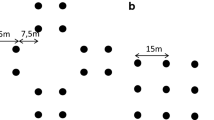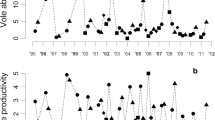Abstract
We interpret gradients in population dynamics of the gray-sided vole from the southwestern part of the island of Hokkaido to its northeastern part within the framework of a phenomenological model involving the relative length of summer and winter. In Hokkaido, as in other northern regions, both spring and fall is considered as short transition periods between the two main seasons — summer (the primary breeding season) and winter (the non-reproductive or secondary breeding season). We show that the geographic transition in dynamics may be understood as the combined consequence of different patterns of density-dependence during summer and winter, and geographically varying season lengths. Differences are shown to exist between summer and winter with respect to strength of density-dependence. Direct density-dependence, in particular, is stronger during winter than during summer. A model is presented to show how relative lengths of seasons can induce both stable and periodically fluctuating population dynamics. The results are compared and contrasted with what is otherwise known about the gradient in rodent dynamics in Fennoscandia.
Similar content being viewed by others
References
Åström, M., P. Lundberg and S. Lundberg (1996) Population dynamics with sequential density-dependencies.Oikos 75: 174–181.
Bjørnstad, O. N., W. Falck and N. C. Stenseth (1995) A geographic gradient in small rodent density fluctuations: a statistical modelling approach.Proceedings of the Royal Society of London B 262: 127–133.
Bjørnstad, O. N., S. Champely, N. C. Stenseth and T. Saitoh (1996) Cyclicity and stability of grey-sided voles,Clethrionomys rufocanus, of Hokkaido: spectral and Principal components analyses.Philosophical Transactions of the Royal Society of London Series B 351: 867–875.
Bjørnstad, O. N., N. C. Stenseth, T. Saitoh and O. C. Lingjserde (1998a) Mapping the regional transition to cyclicity inClethrionomys rufocanus: spectral densities and functional data analysis.Researches on Population Ecology 40: 77–84.
Bjørnstad, O. N., J.-M. Fromentin, N. C. Stenseth and J. Gjøsæter (1998b) A new test for density-dependent survival: the case of coastal cod populations.Ecology (in press).
Bujalska, G. (1975) Reproduction and mortality of bank voles and the changes in the size of an island population.Acta Theriologica 20: 41–56.
Chitty, D. (1952) Mortality among voles(Microtus agrestis) at Lake Vyrnwy, Montgomeryshire in 1936–39.Philosophical Transactions of the Royal Society of London Series B 236: 505–552.
Cockburn, A. (1988)Social behaviour in fluctuating populations. Croom Helm. Elton, C. S. ({dy1924}) Periodic fluctuations in the numbers of animals:
their causes and effects.Journal of Experimental Biology 2:119- 163.
Erlinge, S. (1987) Predation and noncyclicity in a microtine population in Southern Sweden.Oikos 50: 347–352.
Formozov, A. N. (1946) Snow cover as an integral factor of the environment and its importance in the ecology of mammals and birds.Materials Fauna and Flora of USSR, New Series, Zoology 5: 1–152 (originally in Russian).
Framstad, E., N. C. Stenseth and E. Østbye (1993) Time series analysis of population fluctuations ofLemmus lemmus. pp. 97–115.In N. C. Stenseth and R. A. Ims (eds.)The biology of lemmings. Academic Press, London.
Framstad, E., N. C. Stenseth, O. N. Bjørnstad and W. Falck (1997) Limit cycles in Norwegian Lemmings: tensions between phase-dependence and density-dependence.Proceedings of the Royal Society of London B 264: 31–38.
Fujimaki, Y. (1975) Reproductive activity inClethrionomys rufocanus bedfordiae 3. Regional differences in autumn reproductive activity.Bulletin of the Hokkaido Forest Experiment Station 13: 38–45. (in Japanese with English summary)
Fuller, W. A. (1967) Ecologie hivernale des lemmings et fluctuations de leurs populations.Terre Vie 114: 97–115.
Gilks, W. R., S. Richardson and D. J. Spiegelhalter (eds.) (1996)Markov chain Monte Carlo in practice. Chapman & Hall, London.
Grenfell, B. T., B. M. Bolker and A. Kleczkowski (1995) Seasonality and extinction in chaotic metapopulations.Proceedings of the Royal Society of London B 259: 97–103.
Hansen, T., N. C. Stenseth and H. Henttonen (1998) Multiannual vole cycles and population regulation during long winters: an analysis of seasonal density dependence. (in review).
Hanski, I. and H. Henttonen (1996) Predation on competing rodent species: a simple explanation of complex patterns.Journal of Animal Ecology 65: 220–232.
Hanski, I., L. Hansson and H. Henttonen (1991) Specialist predators, generalist predators, and the microtine rodent cycle.Journal of Animal Ecology 60: 353–367.
Hanski, I., P. Turchin, E. Korpimäki and H. Henttonen (1993) Population oscillations of boreal rodents: Regulation by mustelid predators leads to chaos.Nature 364: 232–235.
Hansson, L. (1984) Winter reproduction of small mammals in relation to food conditions and population dynamics. pp. 225–234.In J. F. Merritt (ed.)Winter ecology of small mammals. Special Publication of Carnegie Museum of Natural History, 10. Pittsburgh.
Hansson, L. (1987) An interpretation of rodent dynamics as due to trophic interactions.Oikos 50: 308–318.
Hansson, L. and H. Henttonen (1985) Gradients in density variations of small rodents: the importance of latitude snow cover.Oecologia 67: 394–402.
Hansson, L. and H. Henttonen (1988) Rodent dynamics as community processes.Trends in Ecology and Evolution 3: 195–200.
Henttonen, H., A. Kaikusalo, J. Tast and J. Viitala (1977) Inter-specific competition between small rodents in subarctic and boreal ecosystems.Oikos 29: 581–590.
Henttonen, H., T. Oksanen, A. Jortikka and V. Haukisalmi (1987) How much do weasels shape microtine cycles in the northern Fennoscandian taiga?Oikos 50: 353–365.
Hörnfeldt, B. (1994) Delayed density dependence as a determinant of vole cycles.Ecology 75: 791–806.
Ishibashi, Y., T. Saitoh and M. Kawata (1998a) Social organization of the voleClethrionomys rufocanus and its demographic and genetic consequences: a review.Researches on Population Ecology 40: 39–50.
Ishibashi, Y., T. Saitoh, S. Abe and M. C. Yoshida (1998b) Kin-related social organization in a winter population of the voleClethrionomys rufocanus.Researches on Population Ecology 40: 51–59.
Itô, Y. (1972) On the methods of determining density-dependence by means of regression.Oecologia 10: 347–372.
Jedrzejewski, W. and B. Jedrzejewska (1996) Rodent cycles in relation to biomass and productivity of ground vegetation and predation in the Palearctic.Acta Theriologica 41: 1–34.
Kalela, O. (1957) Regulation of reproduction rate in subarctic populations of the vole,Clethrionomys rufocanus (Sund.).Annales Academiae Scientiarum Fennicae, Series A, IV Biologica 34: 1–60.
Kalela, O. (1962) On the fluctuations in the numbers of arctic and boreal small rodents as a problem of production biology.Annales Academiae Scientiarum Fennicae, Series A, IV, Biologica 66:1–38.
Kaneko, Y., K. Nakata, T. Saitoh, N. C. Stenseth and O.N. Bjørnstad (1998) The biology of the voleClethrionomys rufocanus: a review.Researches on Population Ecology 40: 21–37.
Kataev, G. D., J. Suomela and P. Palokangas (1994) Densities of microtine rodents along a pollution gradient from a copper-nickel smelter.Oecologia 97: 491–498.
Kira, T. (1949) Fundamental problems of climate classification.Seibutsu Kagaku (Biological Science)1: 193–199 (in Japanese).
Kira, T. (1971)Nature from the ecological view point. Kawaideshobo, Tokyo (in Japanese).
Korpimäki, E. (1993) Regulation of mulitannual vole cycles by density-dependent avian and mammalian predation.Oikos 66: 359–363.
Korpimäki, E. (1994) Rapid or delayed tracking of multi-annual vole cycles by avian predators?Journal of Animal Ecology 63: 619–628.
Korpimäki, E. and K. Norrdahl (1991) Do breeding nomadic avian predators dampen population fluctuations of small mammals?Oikos 62: 195–208.
Koshkina, T. V. (1966) On the periodical changes in the numbers of voles.Bulletin of the Moscow Society of Naturalists, Biological Section 71: 1–26.
Kot, M. and W. M. Scahffer (1984) The effects of seasonality on discrete models of population growth.Theoretical Population Biology 26: 340–360.
Laine, K. and H. Henttonen (1983) The role of plant production in microtine cycles in northern Fennoscandia.Oikos 40: 407–418.
Laine, K. and H. Henttonen (1987) Phenolics/nitrogen ratio in the bilberryVaccinium myrtillus in relation to temperature and microtine density in Finnish Lapland.Oikos 50: 389–395.
Lebreton, J.-D. (1990) Modelling density dependence, environmental variability, and demographic stochasticity from population counts: An example using Wytham Wood great tits. pp. 89–102.In J. Blondel, A. Gosier, J.-D. Lebreton and R. McCleery (eds.)Population biology of the passerine birds. Springer-Verlag, Berlin.
Lindström, E. R. and B. Hörnfeldt (1994) Vole cycles, snow depth and fox predation.Oikos 70: 156–160.
Marcström, V., N. Höglund and C. J. Krebs (1990) Periodic fluctuations in small mammals at Boda, Sweden from 1961 to 1988.Journal of Animal Ecology 59: 753–761.
Merritt, J. F. (ed.) (1984)Winter ecology of small mammals. Special Publication of Carnegie Museum of Natural History, 10. Pittsburgh.
Mallorie, H. C. and J. R. Flowerdew (1994) Woodland small mammal population ecology in Britain: a preliminary review of the Mammal Society survey of wood miceApodemus sylvaticus and bank volesClethrionomys glareolus, 1982–87.Mammal Review 24: 1–15.
Ota, K. (ed.) (1984)Study on wild murid rodents in Hokkaido. Hokkaido University Press, Sapporo (in Japanese).
Petrusewicz, K., G. Bujalska, R. Andrzejewski and J. Gliwicz (1971) Productivity processes in an island population ofClethrionomys glareolus.Annales Zoologici Fennici 8: 127–132.
Pielou, E. C. (1977)Mathematical ecology. Wiley & Sons, New York.
Pitelka, F. A. (1957) Some aspects of population structure in the short-term cycle of the brown lemming in Northern Alaska.Cold Spring Harbor Symposia on Quantitative Biology 18: 237–251.
Rinaldi, S., S. Muratori and Y. Kuznetsov (1993) Multiple attractors, catastrophes and chaos in seasonally perturbed predator prey communities.Bulletin of Mathematical Biology 55: 15–35.
Royama, T. (1992)Analytical population dynamics. Chapman and Hall, London.
Saitoh, T. (1987) A time series and geographical analysis of population dynamics of the red-backed vole in Hokkaido, Japan.Oecologia 73: 382–388.
Saitoh, T. and K. Takahashi (1998) The role of vole populations in prevalence of the parasite(Echinococcus multilocularis) in foxes.Researches on Population Ecology 40: 97–105.
Saitoh, T., N. C. Stenseth and O. N. Bjørnstad (1997) Density dependence in fluctuating grey-sided vole populations.Journal of Animal Ecology 66: 14–24.
Saitoh, T., N. C. Stenseth and O. N. Bjørnstad (1998a) The population dynamics of the voleClethrionomys rufocanus in Hokkaido, Japan.Researches on Population Ecology 40: 61–76.
Saitoh, T., O. N. Bjørnstad and N. C. Stenseth (1998b) Density-dependence in voles and mice: a comparative study.Ecology (in press).
Schwarz, S. S. (1963) Actaptations of terrestrial vertebrates to the environmental conditions of the subarctic. Academy of Sci. USSR, Ural Affiliatie, Inst. Biol., Trudy33: 1–19 (originally in Russian).
Schwarz, S. S. (1977)The evolutionary ecology of animals. Consultant Bureau, New York (originally in Russian).
Schwarz, S.S., A. V. Pokrowski, V. G. Istchenko, V. G. Olenjey, N. A. Ovtschinnikova and O. A. Pjastolova (1964) Biological peculiarities of seasonal generation of rodents with special references to the problem of senescence in mammals.Acta Theriologica 8: 11–43.
Stenseth, N. C. (1978) Demographic strategies in fluctuating populations of small rodents.Oecologia 33: 149–172.
Stenseth, N. C. and R. A. Ims (eds.) (1993)The biology of lemming. Academic Press, London.
Stenseth, N. C, O. N. Bjørnstad and T. Saitoh (1996a) A gradient from stable to cyclic populations ofClethrionomys rufocanus in Hokkaido, Japan.Proceedings of the Royal Society of London B 263: 1117–1126.
Stenseth, N. C, O. N. Bjørnstad and W. Falck (1996b) Is spacing behaviour coupled with predation causing the microtine density cycle? A synthesis of process-oriented and pattern-oriented studies.Proceedings of the Royal Society of London B 263: 1423–1435.
Stenseth, N. C, W. Falck, O. N. Bjørnstad and C. J. Krebs (1997) Population regulation in snowshoe hare and lynx populations: asymmetric food web configurations between the snowshoe hare and the lynx.Proceedings of the National Academy of Science of the USA 94: 5147–5152.
Stenseth, N. C, T. Saitoh and N. G. Yoccoz (1998a) Frontiers in population ecology of microtine rodents: a pluralistic approach to the study of population ecology.Researches on Population Ecology 40: 5–20.
Stenseth, N. C, R. Boonstra, N. G. Yoccoz and C. J. Krebs (1998b) Population cycles in lemmings and voles: dynamics and demographic signatures of non-linearity. (in review).
Turchin, P. and I. Hanski (1997) An empirically based model for latitudinal gradient in vole population dynamics.American Naturalist 149: 842–874.
Viitala, J. (1977) Social organization in cyclic subarctic populations of the volesClethrionomys rufocanus (Sund.) andMicrotus agrestis (L.).Annales Zoologici Fennici 14: 53–93.
Yoccoz, N. G., K. Nakata, N. C. Stenseth and T. Saitoh (1998) The demography ofClethrionomys rufocanus: from mathematical and statistical models to further field studies.Researches on Population Ecology 40: 107–121.
Author information
Authors and Affiliations
Corresponding author
Rights and permissions
About this article
Cite this article
Stenseth, N.C., Bjørnstad, O.N. & Saitoh, T. Seasonal forcing on the dynamics ofClethrionomys rufocanus: Modeling geographic gradients in population dynamics. Res Popul Ecol 40, 85–95 (1998). https://doi.org/10.1007/BF02765224
Received:
Accepted:
Issue Date:
DOI: https://doi.org/10.1007/BF02765224




